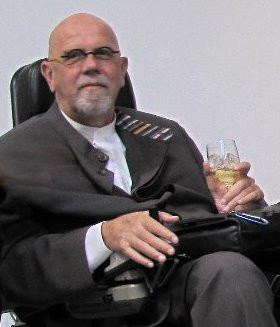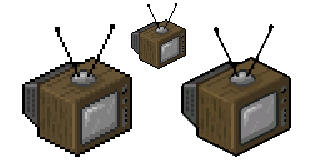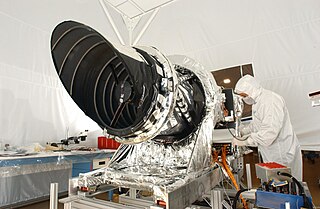
In digital imaging, a pixel, pel, or picture element is the smallest addressable element in a raster image, or the smallest addressable element in a dot matrix display device. In most digital display devices, pixels are the smallest element that can be manipulated through software.

A binary image is one that consists of pixels that can have one of exactly two colors, usually black and white. Binary images are also called bi-level or two-level, Pixelart made of two colours is often referred to as 1-Bit or 1bit. This means that each pixel is stored as a single bit—i.e., a 0 or 1. The names black-and-white, B&W, monochrome or monochromatic are often used for this concept, but may also designate any images that have only one sample per pixel, such as grayscale images. In Photoshop parlance, a binary image is the same as an image in "Bitmap" mode.
In digital signal processing, spatial anti-aliasing is a technique for minimizing the distortion artifacts (aliasing) when representing a high-resolution image at a lower resolution. Anti-aliasing is used in digital photography, computer graphics, digital audio, and many other applications.

Pixel art is a form of digital art drawn with graphical software where images are built using pixels as the only building block. It is widely associated with the low-resolution graphics from 8-bit and 16-bit era computers and arcade video game consoles, in addition to other limited systems such as LED displays and graphing calculators, which have a limited number of pixels and colors available. The art form is still employed to this day by pixel artists and game studios, even though the technological limitations have since been surpassed.

The Game Boy Camera, released as Pocket Camera in Japan, is a Nintendo accessory for the handheld Game Boy game console. It was released on February 21, 1998, in Japan, and manufacturing was ceased in late 2002. As a toy for user-generated content, it can be used to shoot grayscale photographs, edit them or create original drawings, and transfer images between GBC units or to the 64DD art game suite Mario Artist. The accessory featured a 180°-swivel front-facing camera that allowed users to capture selfies. Its images can be printed to thermal paper with the Game Boy Printer. The GBC's cartridge contains minigames based on Nintendo's early games such as the arcade video game Space Fever and the Game & Watch handheld game Ball, and a chiptune music sequencer; photographers have embraced its technological limitations as artistic challenges.

Charles Thomas Close was an American painter, visual artist, and photographer who made massive-scale photorealist and abstract portraits of himself and others. Close also created photo portraits using a very large format camera. He adapted his painting style and working methods in 1988, after being paralyzed by an occlusion of the anterior spinal artery.

A flip book, flipbook, flicker book, or kineograph is a booklet with a series of images that very gradually change from one page to the next, so that when the pages are viewed in quick succession, the images appear to animate by simulating motion or some other change. Often, flip books are illustrated books for children, but may also be geared toward adults and employ a series of photographs rather than drawings. Flip books are not always separate books, but may appear as an added feature in ordinary books or magazines, frequently using the page corners. Software packages and websites are also available that convert digital video files into custom-made flip books.
Boing Boing is a website, first established as a zine in 1988, later becoming a group blog. Common topics and themes include technology, futurism, science fiction, gadgets, intellectual property, Disney, and left-wing politics. It twice won the Bloggies for Weblog of the Year, in 2004 and 2005. The editors are Mark Frauenfelder, David Pescovitz, Carla Sinclair, and Rob Beschizza, and the publisher is Jason Weisberger.

Pixel-art scaling algorithms are graphical filters that enhance hand-drawn 2D pixel art graphics. The re-scaling of pixel art is a specialist sub-field of image rescaling.

In computer graphics and digital imaging, imagescaling refers to the resizing of a digital image. In video technology, the magnification of digital material is known as upscaling or resolution enhancement.

Digital photography uses cameras containing arrays of electronic photodetectors interfaced to an analog-to-digital converter (ADC) to produce images focused by a lens, as opposed to an exposure on photographic film. The digitized image is stored as a computer file ready for further digital processing, viewing, electronic publishing, or digital printing. It is a form of digital imaging based on gathering visible light.

An image sensor or imager is a sensor that detects and conveys information used to form an image. It does so by converting the variable attenuation of light waves into signals, small bursts of current that convey the information. The waves can be light or other electromagnetic radiation. Image sensors are used in electronic imaging devices of both analog and digital types, which include digital cameras, camera modules, camera phones, optical mouse devices, medical imaging equipment, night vision equipment such as thermal imaging devices, radar, sonar, and others. As technology changes, electronic and digital imaging tends to replace chemical and analog imaging.

High Resolution Imaging Science Experiment is a camera on board the Mars Reconnaissance Orbiter which has been orbiting and studying Mars since 2006. The 65 kg (143 lb), US$40 million instrument was built under the direction of the University of Arizona's Lunar and Planetary Laboratory by Ball Aerospace & Technologies Corp. It consists of a 0.5 m (19.7 in) aperture reflecting telescope, the largest so far of any deep space mission, which allows it to take pictures of Mars with resolutions of 0.3 m/pixel, resolving objects below a meter across.
In art, appropriation is the use of pre-existing objects or images with little or no transformation applied to them. The use of appropriation has played a significant role in the history of the arts. In the visual arts, "to appropriate" means to properly adopt, borrow, recycle or sample aspects of human-made visual culture. Notable in this respect are the readymades of Marcel Duchamp.
Thomas Roma is an American photographer who has worked almost exclusively since 1974 exploring the neighborhoods and institutions of his native Brooklyn, photographing scenes from churches, subways and everyday life. His work, made almost exclusively using a homemade camera, has received widespread acclaim.

Moon Museum is a small ceramic wafer three-quarters by one-half inch in size, containing artworks by six prominent artists from the late 1960s. The artists with works in the "museum" are Robert Rauschenberg, David Novros, John Chamberlain, Claes Oldenburg, Forrest Myers and Andy Warhol.

Witch Doctor is a US comic book created by writer Brandon Seifert and artist Lukas Ketner. It was the first title published by Skybound Entertainment, an imprint of Image Comics. As of early 2014, Witch Doctor consists of a four-issue mini-series, an issue #0 printed as a flipbook with The Walking Dead #85, a one-shot subtitled Witch Doctor: The Resuscitation, and a second six-issue mini-series entitled Witch Doctor: Mal Practice, which debuted in November 2012. The first mini-series and #0 issue were reprinted in a collected edition called Witch Doctor Vol. 1: Under the Knife, while the second mini-series and The Resuscitation are scheduled to be collected as Witch Doctor Vol. 2: Mal Practice in June 2013.

Pixel Camera, formerly Google Camera, is a camera phone application developed by Google for the Android operating system. Development for the application began in 2011 at the Google X research incubator led by Marc Levoy, which was developing image fusion technology for Google Glass. It was publicly released for Android 4.4+ on the Google Play on April 16, 2014. It was initially supported on all devices running Android 4.4 KitKat and higher, but became only officially supported on Google Pixel devices in the following years. The app was renamed Pixel Camera in October 2023, with the launch of the Pixel 8 and Pixel 8 Pro.

DALL-E, DALL-E 2, and DALL-E 3 are text-to-image models developed by OpenAI using deep learning methodologies to generate digital images from natural language descriptions, called "prompts". The original DALL-E was revealed by OpenAI in a blog post in January 5, 2021, and uses a version of GPT-3 modified to generate images. In April 6, 2022, OpenAI announced DALL-E 2, a successor designed to generate more realistic images at higher resolutions that "can combine concepts, attributes, and styles". In September 2023, OpenAI announced their latest image model, DALL-E 3, capable of understanding "significantly more nuance and detail" than previous iterations.
Prequel, Inc. is an American technology company and mobile app developer known for developing the Prequel mobile application, which enables editing photos and videos with filters and effects generated using artificial intelligence. Prequel was founded in 2018 by Serge Aliseenko and Timur Khabirov, who currently serves as the company’s CEO. It is headquartered in New York City. As of August 2022, it had been downloaded more than 100 million times.












